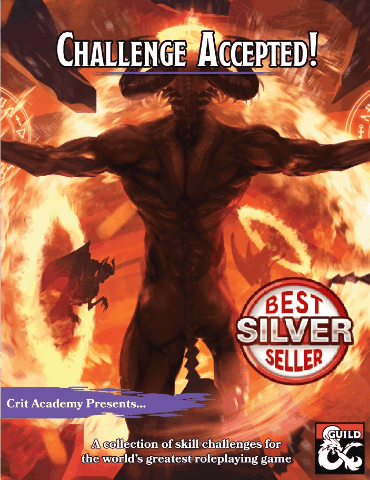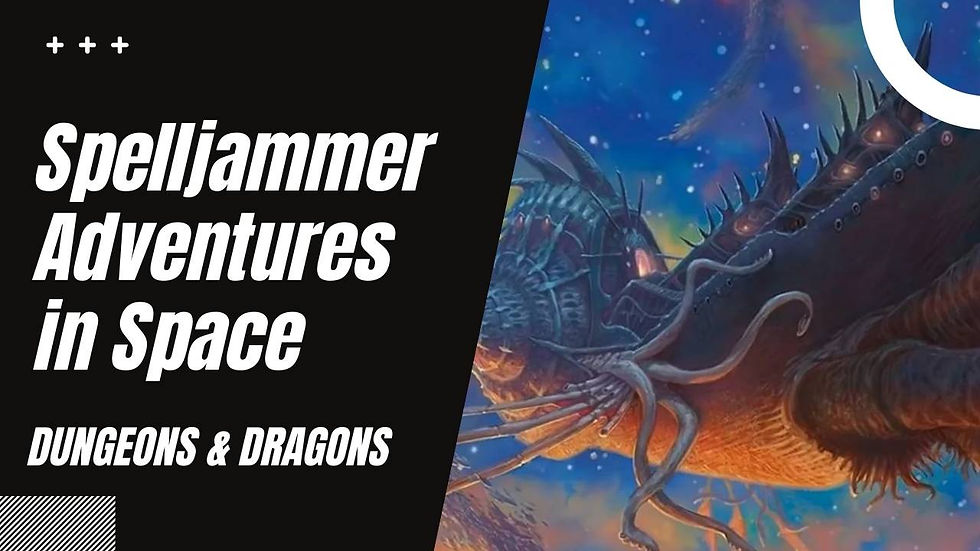It's a Trap!
- Justin Handlin

- Feb 10, 2020
- 6 min read

Crit Academy discusses Trap design in Dungeons and Dragons. Traps and hazards are inanimate threats to life, limb, mind, or spirit. One wrong step in an ancient tomb triggers a series of scything blades that cleave through armor and bone. The seemingly innocuous vines that hang over a cave entrance grasp and choke at anyone foolish enough to push through them. A narrow stone bridge leads over a pit filled with hissing, sputtering acid. In the D&D game, monsters are only one of many challenges that adventurers face.
Join us as we discuss how to design fun and interesting traps that your players will enjoy.
Unearthed Tips and Tricks: (New and reusable D&D content for you to bring with you on your next adventure.)
Character Concept:
Lost their Fortune:
Before the campaign began, your character was extremely wealthy. However, due to
circumstances for you to determine, your wealth has been lost. Maybe your family’s estate
was destroyed in a natural disaster, and you’re left on the streets with nothing. Maybe you were blackmailed by a rival (either for something you did, or something you’ve been framed for). Maybe your family used your fortune to back the previous king, and a coup has caused an upset that has torn away your status.
The reason this can be interesting is that the nature of your fall from grace can be a hook
for an entire campaign. The DM could build numerous encounters around finding the
evidence that’s being used to blackmail you, and your end goal could be to bring your rival
to justice. Perhaps the previous king is still out there, and he’s mustering forces to take his
throne back by force The more interesting your character’s backstory, the more the DM can use it to make an interesting game!
Just remember: if you do get your fortune back, don’t let it go to your head.
Monster Variant:
Young Kraken
These slimy beasts are a constant reminder of the dangers of the open sea for merchants and fisherman alike. These massive underwater creatures have a large, conical, arrowhead,
dinner-plate sized eyes, and a nasty four foot talon like beak on its underside. Surrounding the beak are eight large tentacles.
Origin: Giant Octopus
New Features
Fling. One large or smaller creature or object grappled by the young kraken is thrown up to 30 feet in a random direction and knocked prone. If a thrown target strikes a solid surface, the target takes 3 (1d6) bludgeoning damage for every 10 feet it was thrown. If the target is thrown at another creature, that creature must succeed on a DC 14 Dexterity saving throw or take the same damage and be knocked prone.
Legendary Actions
The young kraken can take 1 legendary action, choosing from the options below. Only one
legendary action can be used at a time and only at the end of another creature’s turn. The young kraken regains spent legendary actions at the start of its turn.
Shipwreck. While underwater, the Young Kraken can spend its action to ram itself into a nearby ship. All creatures on the ship must make a DC 14 Dex save or fall prone. Anyone within 5 feet of the edge of the ship, however, are knocked overboard instead of falling prone.
Fling. The young kraken uses its Fling.
Encounter Concept:
Goblin Diplomacy
The players are hired to investigate (or just randomly stumble upon) a brutal war being fought between two tribes of goblins. They’ve been warring between themselves for some
time, and now their feud is starting to bleed over into the civilized world. Trade routes are being cut off, travelers are being waylaid or killed, and the local government doesn’t know how to deal with the problem.
That’s where the party comes in. They can choose to deal with th goblins peacefully
(infiltrate each group and set up a parlay between the leaders, pose as a goblin deity to
tell them to set aside their differences, unite them against a common enemy, etc.), or they
can choose to deal with them by force. Whatever option they choose, you should make sure there are good and bad consequences. If they unite the goblins, they might gain some powerful allies in the future, but at the same time, the united goblin force becomes bigger and stronger and starts spreading to other areas of the world. If they choose to kill all of the goblins, it solves the problem and makes the area safer, but eventually a bigger, badder threat will show up to fill the void.
As the DM, you should try to make the feud between the tribes fit the tone of the campaign.
In a dark, gritty campaign, it could be that the two tribes were once one tribe until a bloody
coup left two goblin brothers at each other’s throats. In a more light-hearted campaign,
maybe the leaders of both tribes found a funny hat lying on the road one day and now they’re fighting over who gets to wear it.
Magic Item:
Vial of Binding
Potion, uncommon
You find a globe-shaped glass vial that fits easily in your hand. Inside the container, two
liquids slosh around, staying separate despite being contained together. Where the two liquids touch, the substances glow brightly, and if you stare too long at the roiling mixture it leaves lightning-shaped spots in your vision. Rather than being consumed like most potions, this item is used by vigorously shaking up the liquids contained within before throwing the
bottle up to 60 feet away.
Upon shattering, the combined liquids create a sudden explosion of light which blinds every
creature within a 15 foot radius until the end of their next turn (unless they can succeed on a
DC 15 Constitution save). A creature that knows the effect is coming can avert their eyes as a
reaction, granting them advantage on the save. Creatures who have no eyes are immune to this effect.
Legends tell of a more powerful version of this spell that, in addition to creating a blinding
flash, creates a cacophonous roar that deafens affected creatures in addition to blinding them.
DM Tip:
Interrupt your Players
Now, the title for this DM tip is a bit misleading. You don’t want to interrupt your players, but
you want to interrupt your player characters. Are the player characters taking a long time to
work out the plan for ambushing the enemies on the road ahead? Have the enemies show up early, or ambush the players instead. Are the players having a long conversation with an NPC in a tavern, and you want to break up the flow to get everyone’s attention? Have a brawl break out and see how the players deal with it. Best of all, interrupt your players while they’re resting.
If the players can take a short rest any time they want by just saying “we rest for an hour”
without any fear of interruption, then there’s no reason for them not to do so. Instead, have
some enemies show up while they’re taking a short rest. While they’re resting in the inn at
night, have a thief show up to steal from them. They’ll be in a position to stop the theft, but
they’ll be unprepared and they’ll have to solve the encounter without all of the resources they typically have.
Have enemies show up while the spellcaster is performing a long ritual. Remember, if
an ability takes a certain amount of time to use, that length of time is pointless if there’s
no chance of anything disturbing it. What difference does it make if the casting time is one
minute vs. one hour vs. one day if it’s all going to boil down to “okay, we cast the spell, what
happens now?” By interrupting players during events like these, you reinforce the importance and variety in the rules by reminding players that different abilities have different costs.
Of course, don’t interrupt your players all the time. If you do, it’ll get predictable and
annoying. Instead, do it once in a while, usually at a time when it’ll have the most impact.
Player Tip: Don't be a Dick! You can avoid dickitude by...
Enhance your Rituals
When you cast rituals in your game, do you just say, “Okay, I cast this spell as a ritual. Ten
minutes pass, what happens?” You might, because lots of players do that. Why not put
in a little bit of work to make your rituals meaningful and exciting?
When you cast a ritual, describe what your character does. Do you draw out arcane glyphs
on the floor and light candles to focus the magical energies? Do you take out your spell
component pouch and sprinkle some bone dust on your head while crushing the skull of an
enemy under your boot, or do you perform an ancient dance using your arcane focus as an
extension of your body? What are the visual effects of your ritual? What does it sound like?
What does it smell like?
These aren’t necessary when playing a ritual caster, but imagine how much more immersive
the game will be when you describe all of these sights and sounds to the other players. If you feel like it, you could even bring an actual book to the game (maybe something in another language, or a book of rhymes or poetry) and read a line each time you cast a spell. The more work you put into your spells and rituals, the more exciting and memorable they’ll be!
We hope you enjoyed your experience here on Crit Academy, if you did, please consider sharing our show and leaving a review here on itunes.
Support Us:
Subscribe to our Blog and be entered to win phat lootz every week.
Visit our website at www.critacademy.com or become a patron donor and get additional phat loot!















Comments